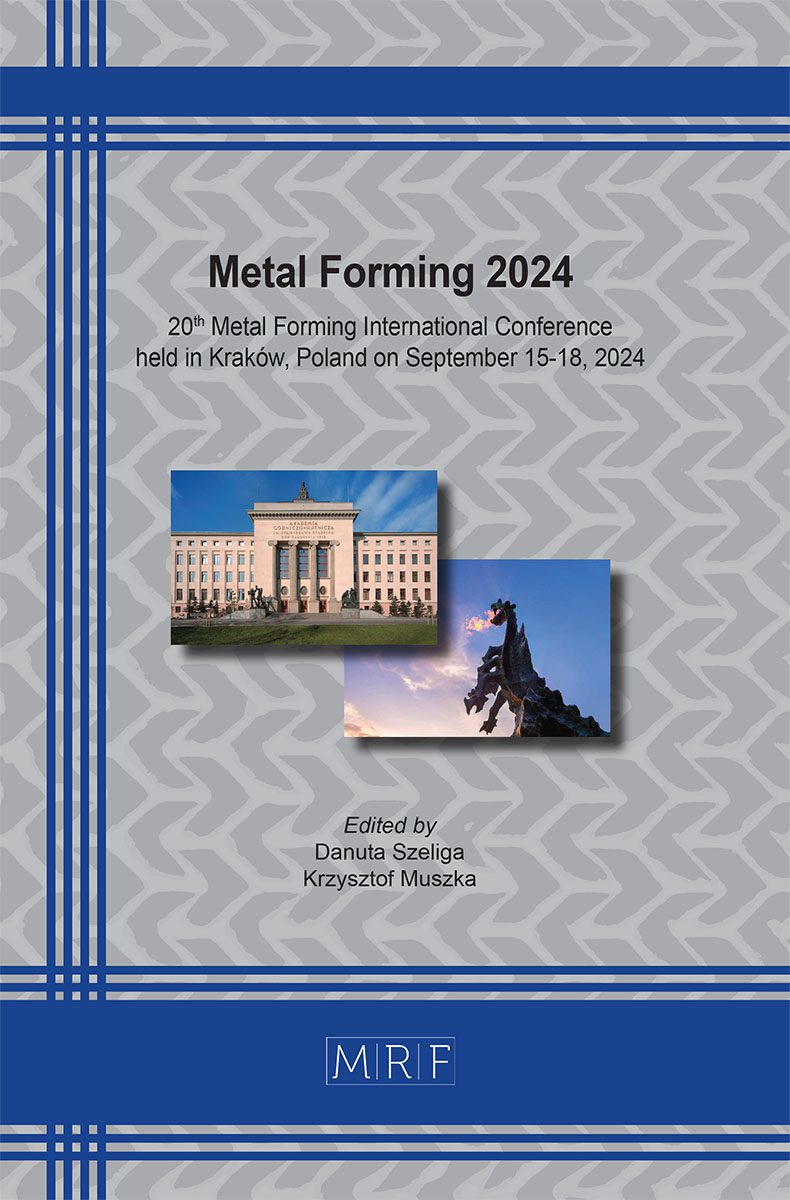–
Material flow analysis in friction stir consolidation during recycling aluminum alloy chips
LATIF Abdul, PULEO Riccardo, INGARAO Giuseppe, MICARI Fabrizio, FRATINI Livan
download PDFAbstract. Friction stir consolidation (FSC) is a solid-state process primarily employed to recycle aluminum machining scrap with the aim to meet the increasing demand of aluminum within the framework of sustainability goals. This technology has recently drawn the attention of many researchers due to its potential beyond the recycling approach to offer plausible new routes for alloying and upcycling metal scraps. Concerning the FSC process, a rotating tool with a certain force is applied to a given batch of chips mass enclosed inside a die chamber turning it into a consolidated billet by friction and stirring action of the tool. The obtained samples are characterized by non-homogenous properties as the non-symmetric nature of the process and therefore different strain levels occur while producing the recycled billet. This study was focused on developing a proper experimental setup to visualize material flow supported with preliminary numerical simulation. The adopted approach led to reveal the deformation during the FSC process in different billet regions by visualizing the shape change of the pre-embedded copper marker in the billet.
Keywords
Friction Stir Consolidation, Recycling, Material Flow, Aluminum Alloys
Published online 9/15/2024, 9 pages
Copyright © 2024 by the author(s)
Published under license by Materials Research Forum LLC., Millersville PA, USA
Citation: LATIF Abdul, PULEO Riccardo, INGARAO Giuseppe, MICARI Fabrizio, FRATINI Livan, Material flow analysis in friction stir consolidation during recycling aluminum alloy chips, Materials Research Proceedings, Vol. 44, pp 158-166, 2024
DOI: https://doi.org/10.21741/9781644903254-18
The article was published as article 18 of the book Metal Forming 2024
![]() Content from this work may be used under the terms of the Creative Commons Attribution 3.0 license. Any further distribution of this work must maintain attribution to the author(s) and the title of the work, journal citation and DOI.
Content from this work may be used under the terms of the Creative Commons Attribution 3.0 license. Any further distribution of this work must maintain attribution to the author(s) and the title of the work, journal citation and DOI.
References
[1] D. Raabe, D. Ponge, P.J. Uggowitzer, M. Roscher, M. Paolantonio, C. Liu, H. Antrekowitsch, E. Kozeschnik, D. Seidmann, B. Gault, F. De Geuser, A. Deschamps, C. Hutchinson, C. Liu, Z. Li, P. Prangnell, J. Robson, P. Shanthraj, S. Vakili, C. Sinclair, S. Pogatscher, Making sustainable aluminum by recycling scrap: The science of “dirty” alloys, Progress Mater. Sci. (2022) 100947. https://doi.org/10.1016/j.pmatsci.2022.100947
[2] J.R. Dufou, A.E. Tekkaya, M. Haase, T. Welo, K. Vanmeensel, K. Kellens, W. Dewulf, D. Paraskevas, Environmental assessment of solid state recycling routes for aluminium alloys: can solid state processes significantly reduce the environmental impact of aluminium recycling?, CIRP Ann. 64 (2015) 37–40. https://doi.org/10.1016/j.cirp.2015.04.051
[3] S. Shamsudin, M.A. Lajis , Z.W. Zhong, Evolutionary in solid state recycling techniques of aluminium: a review, Procedia CIRP 40 (2016) 256-261. https://doi.org/10.1016/j.procir.2016.01.117
[4] D. Baffari, A.P. Reynolds, A. Masnata, L. Fratini, G. Ingarao, Friction stir extrusion to recycle aluminum alloys scraps: Energy efficiency characterization, J. Manuf. Process. 43 (2019) 63-69. https://dx.doi.org/10.1016/j.jmapro.2019.03.049
[5] J.B. Jordon, P.G. Allison, B.J. Phillips, D.Z. Avery, R.P. Kinser, L.N. Brewer, K. Doherty, Direct recycling of machine chips through a novel solid-state additive manufacturing process, Mater. Design 193 (2020) 108850. https://doi.org/10.1016/j.matdes.2020.108850
[6] A. Latif, G. Ingarao, M. Gucciardi, L. Fratini, A novel approach to enhance mechanical properties during recycling of aluminum alloy scrap through friction stir consolidation, Int. J. Adv. Manuf. Tech. 119 (2022) 1989-2005. https://link.springer.com/article/10.1007%2Fs00170-021-08346-y
[7] L. Fratini, G. Buffa, D. Palmeri, J. Hua, R. Shivpuri, Material flow in FSW of AA7075–T6 butt joints: numerical simulations and experimental verifications, Sci. Tech. Weld. Join. 11 (2006) 412-421. https://doi.org/10.1179/174329306X113271
[8] T.U. Seidel, A.P. Reynolds, Visualization of the material flow in AA2195 friction-stir welds using a marker insert technique, Metall. Mater. Trans. A 32 (2001) 2879-2884. https://doi.org/10.1007/s11661-001-1038-1
[9] G.G. Stubblefield, K.A. Fraser, T.W. Robinson, N. Zhu, R.P. Kinser, J.Z. Tew, B.T. Cordle, J.B. Jordon, P.G. Allison, A computational and experimental approach to understanding material flow behavior during additive friction stir deposition (AFSD), Computat. Part. Mech. 1-15 (2023). https://ui.adsabs.harvard.edu/link_gateway/2023CPM….10.1629S/doi:10.1007/s40571-023-00578-x
[10] X. Li, M.R.E. Rabby, M. Ryan, G. Grant, A.P. Reynolds. Evaluation of orthogonal strain components in friction extrusion, J. Mater. Res. Tech. 15 (2021) 3357-3364. https://doi.org/10.1016/j.jmrt.2021.10.001
[11] T. Wei, A.P. Reynolds, Friction consolidation of aluminum chips, Friction Stir Weld. Process. VI (2011) 289-298. https://dx.doi.org/10.1002/9781118062302.ch34
[12] S. Shima, M. Oyane, Plasticity theory for porous metals, Int. J. Mech. Sci. 18 (1976) 285–291. https://doi.org/10.1016/0020-7403(76)90030-8












